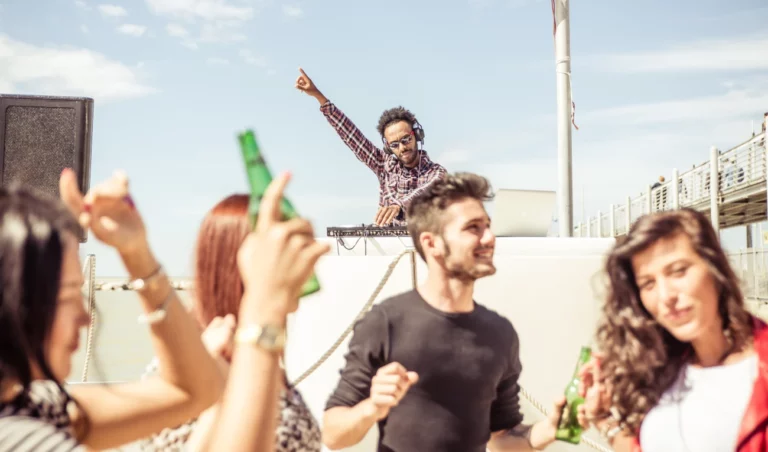- Last Updated:
- 1/25/2025
- Khaleel Hayes
We surveyed our customers and scoured online studies to discover the top DJ statistics and trends for musicians, balloonists, Santa Clauses, and other types of performers.
From artificial intelligence (AI) and music streaming platforms to decorative balloons and glow-in-the-dark face paint, here are the hottest stats and trends right now.
DJ Statistics and Trends for 2025
DJs lay down tracks at a variety of different types of locations and events, such as nightclubs, weddings, proms, corporate parties, online — and more. Here are some DJ facts from real DJs we surveyed:
- 45% said they perform at wedding-related celebrations
- 27% perform at private parties and events
- 13% work in small venues of less than 500 people (like cafes, bars, and clubs)
The job has come a long way from using huge turntables, speakers, and headphones, so let’s see how AI, the cloud, and other tools are enhancing the industry.
DJs Are Mixing It Up With AI – Literally
AI — artificial intelligence — is sweeping every industry with its automation and innovative suggestion capabilities, including DJs.
AI’s versatility could be why MarketsandMarkets predicts the global AI market size could grow by 36.8% annually in the next 7 years and hit $1,339.1 billion in revenue by 2030.
Professional Danceteria DJ Rafe Gomez gave thoughts on how AI can play with the inner mechanics of music:
“AI could potentially make DJing more sonically interesting by allowing transitions from song to song to be maximally seamless and imperceptible.The AI effect could not only match the beats between the songs so that they align perfectly, [but] it could also adjust the volumes, instrumentation, and EQs of the tracks to create an impressive and harmonious musical merge.”
Whether you need new beat ideas or breathtaking visuals for your next set, AI can push you in the right direction.
You can even leverage artificial intelligence to create personalized playlists, which could be essential if you want to host a silent DJ party, for example.
Using Cloud DJing to Streamline and Elevate Performance
DJs are always looking for ways to create the best DJ playlist for audiences. Today, you can stream music on different platforms from virtually anywhere without purchasing anything to widen your music palette.
This trend is also known as cloud DJing. Cloud DJing makes it simple and affordable to explore different genres of music with customizable playlists at your disposal.
Gomez spoke on how this trend reduces the gear DJs lug:
“I remember back in the day [when] spinners would cart around heavy crates of vinyl from gig to gig. It was exhausting and hugely inconvenient.While external hard drives and high-capacity SSD drives are the go-to storage vehicle for digital DJs, the cloud offers even greater convenience and seamlessness for DJs who need reliable access to their libraries.”
Cloud capabilities and music streaming platforms allow you to access information on any internet-connected device. This accessibility may be why Research and Markets predict the music streaming market could be worth $103.07 billion in 2030 with a 14.7% annual growth rate.
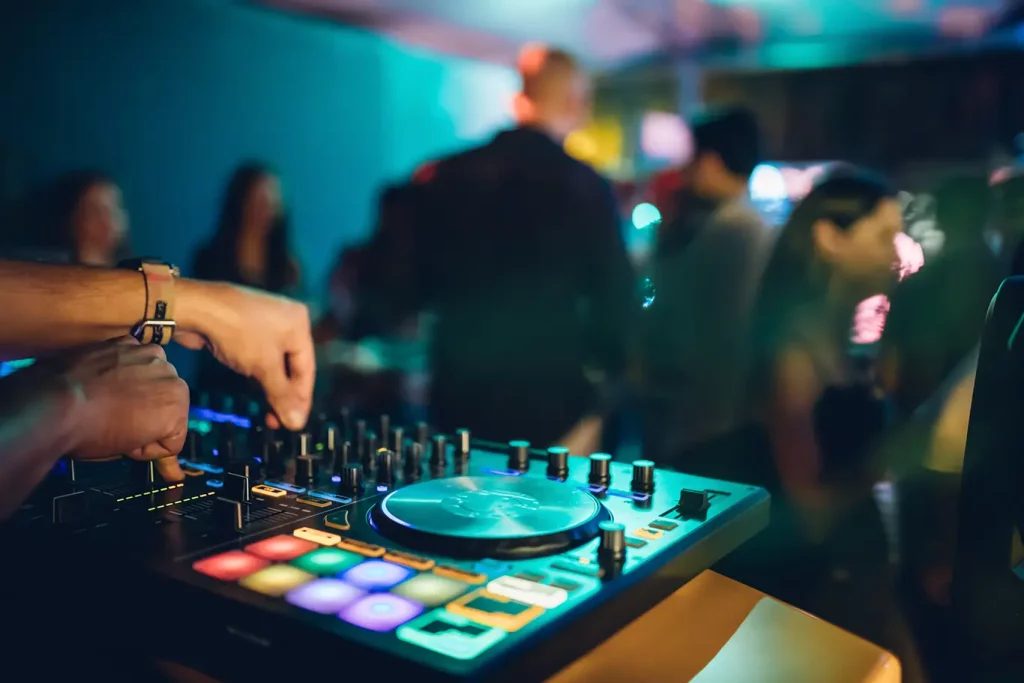
The Hottest Controllers for DJs in 2025
The DJ equipment market is a highly profitable industry. SkyQuest Technology Group estimated that the global DJ consoles market could reach $104.5 billion in value by 2032.
There are numerous DJ controllers, great DJ speakers, and DJ-related software to choose from to give you a truly unique sound for your audience.
Some of the best DJ controllers right now include Pioneer DDJ-FLX10, RANE Four, and Pioneer DJ DDJ-FLX4, offering you the ability to enhance your set in several ways:
- Using color-coded buttons for better organization
- Integrating with Rekordbox and Serato software
- Putting vocals from one track onto another
- Synching track keys and tempos
- Choosing songs from TIDAL, Bearport Streaming, SoundCloud Go+, and other subscribed platforms
Controllers are just one type of equipment to consider, though, so find out what else you need in our guide to DJ equipment.
More Booking Options to Land More DJ Gigs
The emergence of so many messaging, social media, and software apps also means DJs have more ways to schedule and book gigs than ever before. Our research showed that:
- 37% of our DJs prefer their websites as the best scheduling tool
- Nearly 29% like social media message requests
- 13% use paid booking apps like Square, Calendly, and HoneyBook
Some may wonder if there’s a waiting list for specific DJs and entertainers, and the short answer is: yes! Our poll revealed that:
- 13% book out up to a year or more in advance
- 29% of DJs favor booking gigs 6-plus months ahead
- 24% like booking 3–6 months in advance
Online Tools DJs Are Using to Amp Up Promotion
The days when you only had flyers, connections, and personal ads to promote yourself as a DJ are long gone.
Social media posts and advertisements allow you to fast-track your DJ career by promoting your brand globally to anyone with a mobile device, tablet, or PC.
When asked how they promote their business, our data showed that:
- 43% of DJs use social media advertising
- 29% have customer referral programs
- 83% have a presence on Facebook, 41% use Instagram, and 12% use TikTok
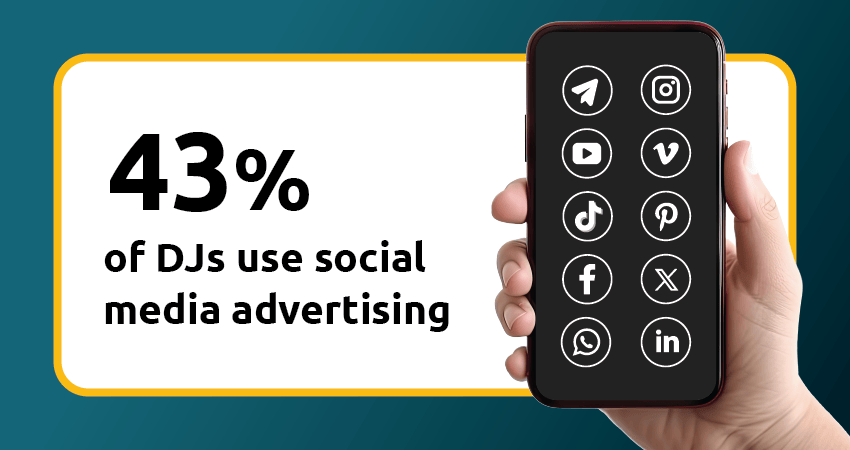
Testing out different platforms can help you understand your fan base and how to use the right media for specific channels.
For example, sharing short video snippets of your shows may work better on TikTok and Instagram but not on Facebook and X.
In this scenario, customer testimonials and photos of clients having a good time on Facebook and X could gain more attention.
Statistics on DJ’s Enhancing the Experience With VR and AR
Imagine using virtual reality (VR) and augmented reality (AR) for DJing.
DJs can use VR and AR to live stream concerts on social media or host and invite fans to interactive concerts using headsets and finger or hand motion technology to mix and scratch in a simulated area.
According to DJMag, Algoriddim’s Djay software can even integrate with Apple’s new Vision Pro VR headset to create a simulated DJ booth with 3D turntables and mixers, dancing robots, and more.
Research and Markets estimates the global AR VR software market to reach $46.16 billion in value by 2030.
Of the DJs who participated in Insurance Canopy’s survey:
- 5% said they regularly performed virtual shows
- 13% haven’t but wanted to
- 27% have only done virtual shows in the past
- 54% haven’t done virtual concerts and weren’t interested in them
Thanks to modern technology, a virtual DJ is more of a reality than something out of a science fiction movie. For the virtual DJs in our survey:
- Approximately 38% said they perform on Facebook
- 28% perform on Twitch
- 23% show off their DJ skills on YouTube and Instagram
- 4% use TikTok.
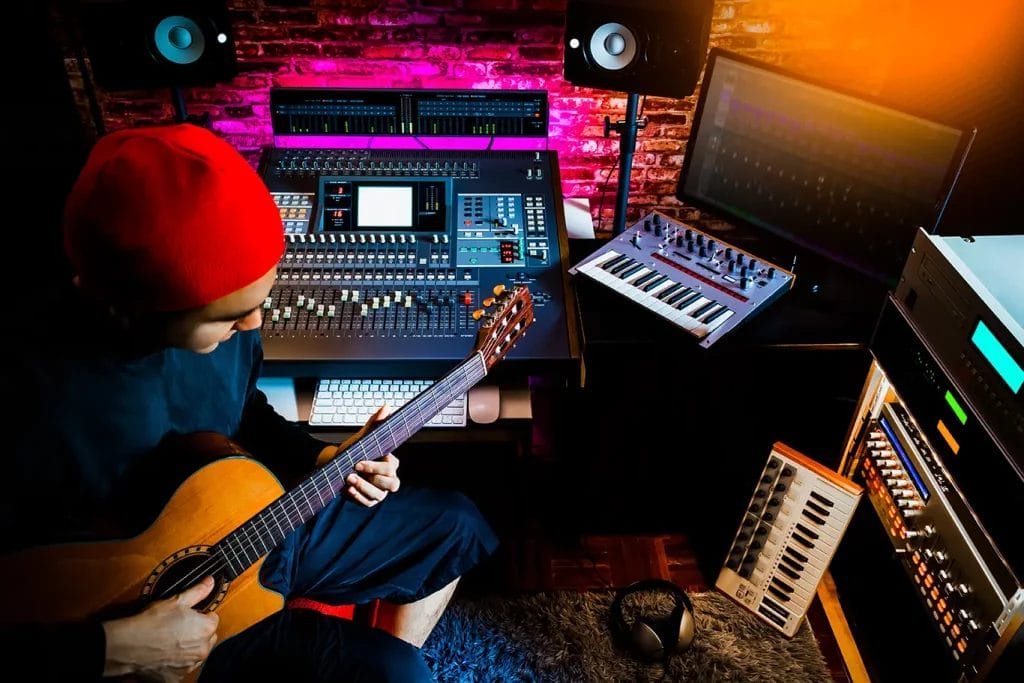
Top Musician Statistics and Trends
Singers like Beyoncé, Taylor Swift, Usher, and Adele know how to keep fans entranced thanks to electrifying hit songs on streaming platforms, sold-out concerts, and the best merch.
Emerging musicians like Chappell Roan, Sabrina Carpenter, Post Malone, and Tyla are also making waves with epic concerts, tours, and album releases.
See how music industry trends like AI, streaming platforms, and super fans keep bands and singers fresh right now.
Statistics on the Makeup of the Music Industry
From average earnings to where music is consumed, here’s a high-level view of musician statistics overall:
- There are 169,300 employed musicians and singers in the U.S. in 2023 (U.S. Bureau of Labor Statistics)
- Musicians made $39.14 per hour on average in 2023
- The music industry is growing at a 2% rate annually — slower than most others
- The average age of professional musicians? 47.1 years old, per Datausa.io
- In 2022, the gender divide for employed musicians was 60.5% male vs 39.5% female
- Alaska is the state with the highest annual salary for musicians at $71,298, followed by California at $54,403
Did you know? The top employers of musicians are religious organizations (37.1%) followed by performing arts companies (22%) and independent performers (18.8%).
Stats on How AI is Changing the Music Industry
AI tech is hitting both high and low notes in the music industry. While you can use AI to enhance music production and songwriting processes, for example, it’s also being used in inappropriate and even illegal ways.
According to Ditto Music, 11% of artists use AI in their songwriting. Per Bedroom Producers Blog’s survey, 36.8% of music producers use AI in their music production workflows.
DJ Rafe Gomez described how this technology could aid musicians of the past:
“What AI is doing, and will continue to do, is make creative exploration possible for artists and songwriters. Ideas such as having beloved deceased singers ‘perform’ new material and also sweetening and improving damaged recordings are two paths where AI can be a solution.”
In 2023, for example, AI helped Paul McCartney and Ringo Starr “resurrect” deceased Beatles members George Harrison and John Lennon to record a new song, “Now and Then,” by isolating Lennon’s voice from an old demo tape.
However, there is controversy around AI in the music world. For example, some people have used this technology to create fake music by mimicking and manipulating the voices of artists such as Frank Sinatra, Justin Bieber, The Weeknd, and more.
To combat the misuse of AI, Tennessee Governor Bill Lee recently signed the Ensuring Likeness Voice and Image Security (ELVIS) Act, which stops fake AI music. This law coincides with the state’s Protection of Personal Rights law. Look for more legislation like this in the future as artists and content creators of all kinds seek similar protection.
In June 2024, Suno Inc. and Uncharted Labs Inc. — both known for their generative Suno AI and Udio AI programs — were hit with copyright infringement lawsuits from record label giants Sony Music Entertainment, Universal Music Group, and Warner Records Inc.
The suits claim that the Suno and AI programs were “trained” to create songs that closely resemble songs from the record companies’ catalogs. The case is ongoing.
Universal Music Group is also filing a similar lawsuit with Concord Music Group and ABKCO against Anthropic that started in fall 2023.
Despite AI’s controversies, this technological trend can enhance a singer or band’s approach to the music world. In fact, 60% of musicians are already using AI to aid in songwriting, production, artwork, and more.
Musician Streaming Services Statistics
Music streaming platforms like Spotify, TIDAL, Apple Music, and others have changed the music listening experience.
Fans now have access to an extensive music library in the palm of their hands, from K-pop to hip-hop, indie, and more. Music streaming platforms can cater to their tastes with algorithmic playlists and artist recommendations.
This accessibility and variety of artists and songs is a potential reason why Valuates Reports estimates the global music streaming service market could hit a value of $22,610 million in 2030.
For example, more than 626 million people use Spotify to create or find personalized playlists, discover new artists, follow their favorites, buy merch, or search for concert dates. So getting your music on Spotify and other streaming services helps you connect it to the right people.
According to Statista, here is the number of monthly active Spotify users annually over the past five years:
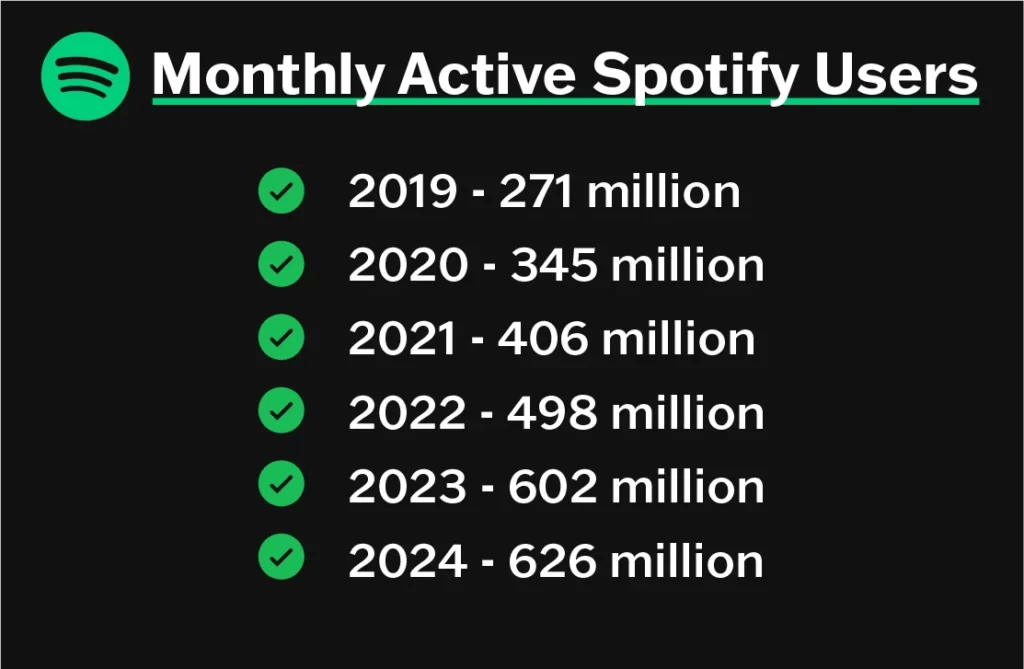
Getting onto streaming platforms is just one way to get discovered. Check out these guides on band and musician marketing:
- How to market yourself as a musician
- Find out how to start a band and book your first gigs
- Learn how to pick the right band name
- See how to find the best gigs for your band
The Trend of Music Super Fans
A few lucky bands and artists also have what are called “stans” or super fans.
Luminate defines a super fan as someone who engages with artists and their content in five-plus ways, including things like following the artist on social media, buying albums and singles, getting merch, attending concerts, and more.
One study estimates that there is about one superfan for every 100 music fans. You probably even know some of them by name:
- Taylor Swift’s “Swifties”
- Lady Gaga’s “Little Monsters”
- The Grateful Dead’s “Deadheads”
- BTS “A.R.M.Y.” (Adorable Representative MC for Youth)
- Beyoncé’s “BeyHive”
- Kesha’s “Animals”
- Ariana Grande’s “Arianators”
- Billie Eilish’s “Avocados”
- BLACKPINK’s “Blinks”
- Normani’s “The Nation” – and more
From live and on-demand streaming to album sales, Luminate’s 2024 Midyear Report mentioned fascinating music industry stats:
- There were 2.29 trillion streams for audio on-demand streaming in 2024 (up from 1.99 trillion in 2023)
- 8.3 million digital album sales in 2024 (vs. 9.2 million in 2023)
- 24.7 million physical album sales in 2024, including CDs, vinyl LPs, and cassette tapes (23.8 million in 2023)
- Top five fastest-growing U.S. core genres:
- Latin
- Rock
- Pop
- Country
- Christian/Gospel
- 48% of consumers enjoy exclusive artist content
- 49% want additional content outside of music
- 50% like live-streaming events, concerts, or live performances
- Live music events make up 64% of monthly music spending
- Almost 15% of U.S. consumers spend time listening to music over watching or playing sports, reading books, or listening to podcasts
In not-so-shocking news, Taylor Swift, whose 2024 ERAS Tour made history, sold the most albums in the United States in 2024.
In fact, she has five albums on the top 10 list of album sales. She also dominated the list of on-demand audio streams, holding three of the seven spots in the top 10.
Top 10 U.S. Album Sales in 2024
- Taylor Swift | The Tortured Poets Department | 2.474 million
- Billie Eilish | Hit Me Hard and Soft | 0.306 million
- Beyoncé | Cowboy Carter | 0.257 million
- Taylor Swift | 1989 (Taylor‘s Version) | 0.250 million
- Taylor Swift | Lover | 0.208 million
- TOMORROW X TOGETHER | Minisode 3: Tomorrow | 0.193 million
- ATEEZ | GOLDEN HOUR: Part 1 | 0.191 million
- Taylor Swift | folklore | 0.174 million
- TWICE | With You-th | 0.174 million
- Taylor Swift | Midnights | 0.171 million
Top 10 U.S. Album On-Demand Audio Streams
- Taylor Swift | The Tortured Poets Department | 2.753 billion
- Morgan Wallen | One Thing At A Time | 2.237 billion
- Noah Kahan | Stick Season | 1.436 billion
- Beyoncé | Cowboy Carter | 1.031 billion
- SZA | SOS | 1.345 billion
- Future & Metro Boomin | We Don‘t Trust You | 1.333 billion
- Morgan Wallen | Dangerous: The Double Album | 1.303 billion
- Zach Bryan | Zach Bryan | 1.188 billion
- Taylor Swift | 1989 (Taylor‘s Version) | 0.910 billion
- Taylor Swift | Lover | 0.961 billion

Statistics Show the Balloon Artistry Is Blowing Up
Balloonists are like magicians — they can turn ordinary balloons into animals, people, and other recognizable shapes for children to enjoy, right before their eyes.
Whether you’re just starting your balloon business or you’re an expert, here are some impressive balloon art-related statistics.
First, Verified Market Research expects the global toy balloon market, aka balloons used for decorations or shaping, to be worth $17.51 billion by 2030.
Also, Adroit Market Research forecasts that the global party balloons market could grow at an annual rate of 4.01% and have a total value of $2.51 billion in 2031.
Santa Claus Statistics to Keep You on the Nice List
A holiday season highlight for many kids is telling Santa everything they want for Christmas. In fact, a mall Santa can expect to see 10,000 or more kids over the 6-week period of every holiday season, accompanied by doting parents willing to spend anywhere from $30-$100 just for a photo.
And it really should come as no surprise: Santa turned 1,753 years old in 2024, which is a tremendous amount of time to build a following. An Ipsos poll offers even more insight:
- 48% say their kids believe in Santa
- 21% of adults believe, too!
- 56% claim they prep their house for Santa just after Thanksgiving
National Santa’s 2023 Red Suit Survey offers interesting statistics about mall Santas:
- 30% of Santas had 100+ children sit on their lap daily; 7% had 500+
- The average age of a Santa performer was 66 years old, the youngest was 20, and the oldest Santa was 88
- 87% don’t need any extra padding to simulate Santa’s stout torso
- 55% pose with pets for pictures, including puppies, kittens, boa constrictors, and more
- 97% said children sneezed or coughed on them daily
- 88% said they’ve had their beards tugged (24% of whom were adult women)
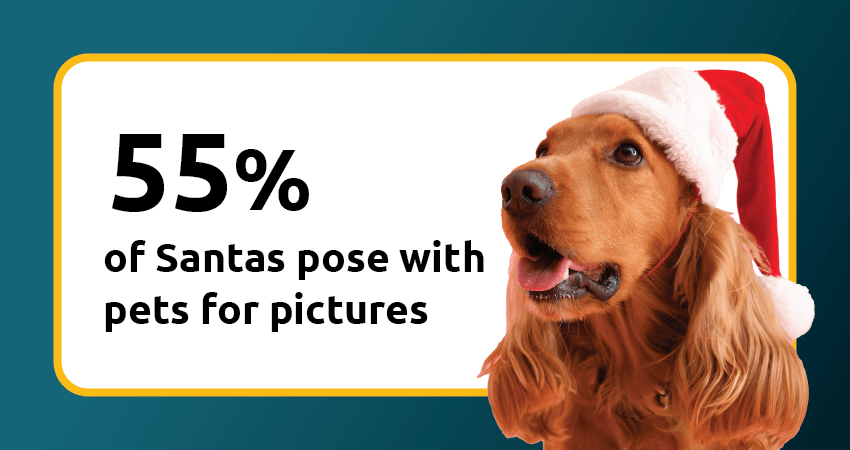
Looking for more information? Check out these Santa Claus guides on our blog:
- How to start a Santa Claus business
- How much Santa Claus performers make
- 7 tips for being the best Santa performer ever
Did you know? There’s even a U.S. town named after Kris Kringle! Santa Claus, Indiana, has a population of 2,614 in 2024, and it’s growing at a rate of 19% annually.
Stats and Trends for Face Painters Looking to Glow Up
Whether it’s for fairs, amusement parks, or your child’s school fundraiser, face painting can make almost any event imaginative and magical.
Market Reports predicts that the ever-expansive face makeup industry could be worth $31,530 million in 2028.
Some popular 2024 face-painting trends hone in on innovation and environmental consciousness. The “in” design styles include patterns with:
- Geometry (i.e., thick lines or triangles)
- Space and galactic themes (e.g. stars, swirls, metallic hues, glow-in-the-dark designs, and more)
- Tech-inspired art like holographic styles or pixelated color schemes
- Big florals
- Neon glows
Designs on the decline include plastic glitter, animals, stencils, one-color looks, and overly complex characters. Here are some more face painter statistics we found:
- Face painters and makeup artists working at amusement parks make $32.97 an hour with an annual average salary of $ 68,590, per the Bureau of Labor Statistics
- Face painters’ rates hinge on factors like demand, skills, and reputation, ranging from $95-$185 an hour, which allows for about 10-15 full faces or 20-25 smaller designs
- Maintaining a professional face painting supplies kit costs from $100-$500 a month (in addition to the initial setup costs of several hundred dollars)
Google Trends also revealed some spooky face painting insights. Just before Halloween, every October, there’s a massive uptick in online searches about “face painting.”
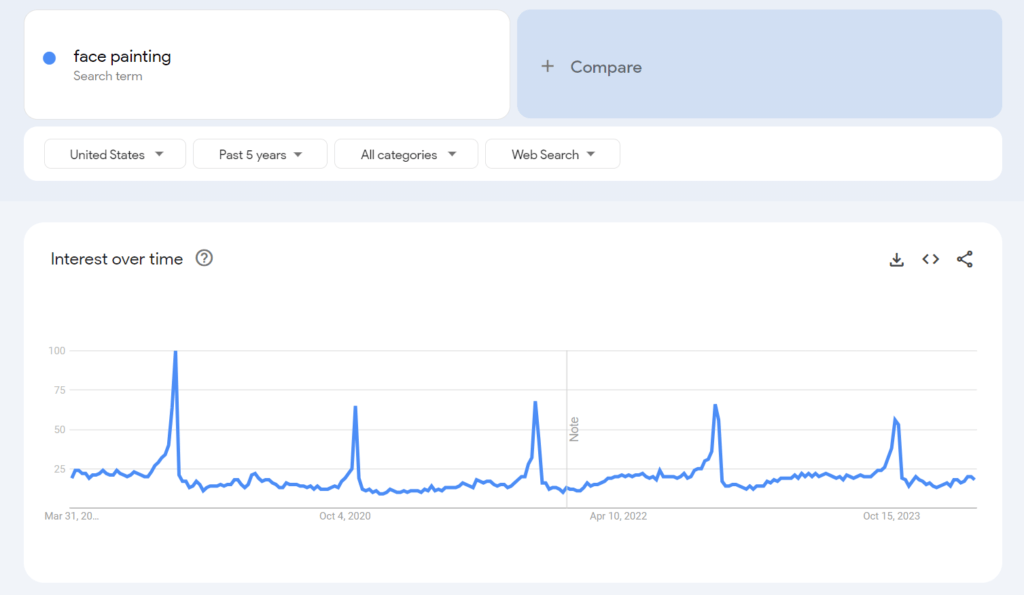
Illusion-Free Magicians Trends and Statistics
Magicians and illusionists of the past and present like David Copperfield, Penn and Teller, and Harry Houdini often replace our disillusionment with child-like wonder at their amazing feats.
And magicians are distinctly on-trend right now with the public.
In fact, TV shows like American’s Got Talent have reinvigorated the magician sector.
In the show’s first 14 seasons, two magicians won, three came in second or third place, four were finalists, and thirteen were semi-finalists. Another show, Penn and Teller: Fool Us, featured over 50 illusionists in its first six seasons alone.
Here are a few magical stats from Vault on the magician profession:
- A magician’s median salary is $33,000, ranging from $17,000 to $88,000
- Professional stage and TV magicians can earn $120,000 or more
- The primary work environment for magicians is homes, schools, magic clubs, and small theaters
- Best locations for those in the magic industry include Las Vegas, New York City, Los Angeles, and Chicago
Interested in a magical career like this? Read up on the supplies every magician needs.
Statistics for Clown Entertainers That Are No Joke
Starting a clown business can make you the center of any party or event.
From colorful costumes and big shoes to red rubber noses, clowns have entertained and kept us laughing for years.
And clown professionals often have overlapping skills with other entertainers, such as balloon artists.
Check out these intriguing clown stats:
- The median salary for a clown performer is $50,000
- Clowns charge about $200 a show, ranging from $150 to $250 on average
- Clown college costs range anywhere from $125 for a 2-day workshop to $6,900 for a 24-week program
- Los Angeles’ The Clown School offers a remote certification program for $500 plus a $100 deposit for 10 lessons, including the history of the clown, the body of a clown, your clown song, and more with founder and lecturer David Bridel
- In the U.S., more men are interested in becoming clown performers than women. However, the profession is currently 71% female vs 29% male performers
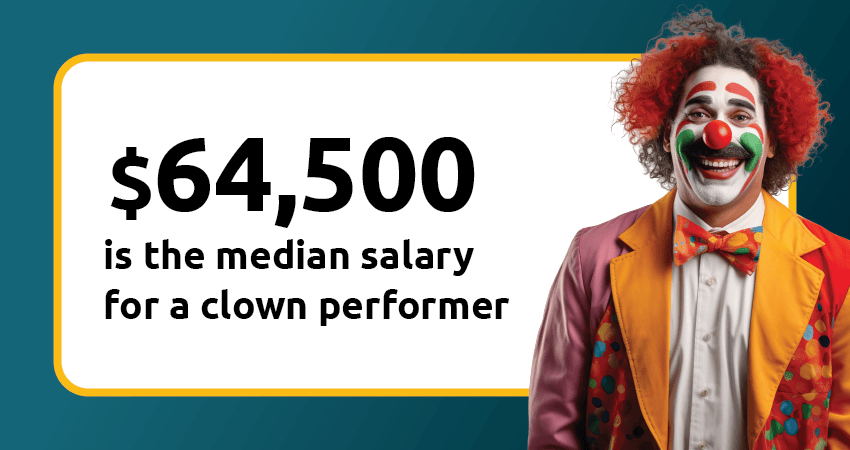
Fun fact: Red Nose Day, which started in the United Kingdom in 1988 and launched in the U.S. in 2015, allows people to look like clowns when they buy a rubber red nose. The proceeds go to impoverished children.
Get an Entertainer Insurance Policy from Insurance Canopy
Insurance Canopy surveyed numerous DJs who had entertainer insurance from us. Of all the respondents, 100% said they’d recommend Insurance Canopy to a friend or colleague.
You can’t argue with these statistics!
Accidents happen, and you could be the one paying for the damages, like someone stealing equipment from your car, kids having allergic reactions to your face paint, or people tripping over cords while you’re setting up your instruments.
Get a free quote online and protect your career in 10 minutes or less.




